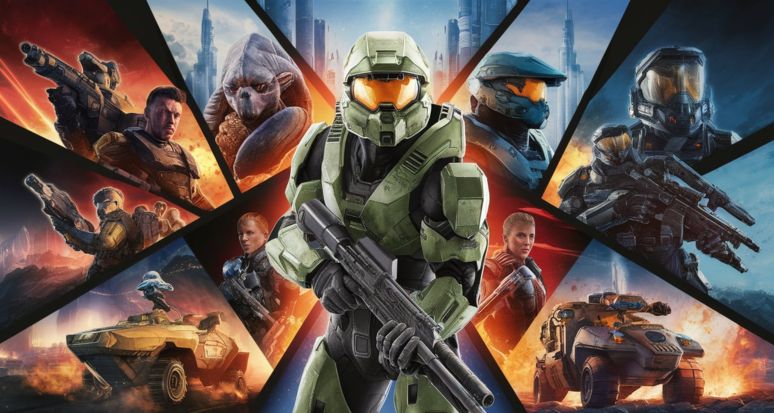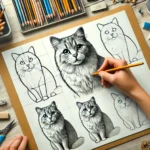Welcome to a journey through the visual world of Halo: Combat Evolved—a game that not only redefined the first-person shooter genre but also set a new standard for the integration of storytelling and gameplay through its meticulously designed halo (2003) game icons banners. Since its release in 2003, Halo has captivated players with its rich narrative and immersive gameplay, supported by a visual language that communicates far more than the sum of its pixels. This post explores how these visual elements contributed to Halo’s success and became a cultural phenomenon in the gaming world.
The Design Philosophy Behind Halo’s Game Icons
Early Concepts and Evolution
The design journey of Halo: Combat Evolved‘s game icons began with a clear vision—to seamlessly integrate functionality with the game’s rich narrative framework. Initially conceived to be simple yet effective, these icons were designed to be instantly recognizable, ensuring that players could understand and react to gameplay cues without hesitation. As the game evolved, so did the icons, which became more detailed and visually cohesive with the game’s expanding universe. This evolution was not just about aesthetic enhancement but also about improving player engagement and interaction.
Design Principles: Simplicity, Functionality, and Memorability
The guiding principles for designing game icons in Halo were simplicity, functionality, and memorability. Each icon, from the depiction of weapons to health bars, was crafted with the intent to communicate essential information quickly and clearly. The design team focused on using distinct shapes and colors to differentiate between items effectively, which helped in reducing the cognitive load on players during high-stress combat scenarios. This approach not only enhanced the usability of the icons but also ensured that they became memorable elements within the gaming community.
Quick Information Table:
| Principle | Description |
|---|---|
| Simplicity | Icons are easy to understand at a glance, avoiding complex designs that could detract from gameplay. |
| Functionality | Each icon serves a clear purpose, effectively communicating game status or actions to the player. |
These design choices set a precedent in game development, illustrating how visual elements can be optimized to improve user experience without sacrificing the game’s immersive experience.
Iconic Game Banners and What They Represent
Symbolism in Banners
Banners in Halo: Combat Evolved play a significant role in deepening the game’s atmosphere and reinforcing its narrative elements. Each faction within the game, from the UNSC (United Nations Space Command) to the alien Covenant, has its unique banners and emblems. These visuals are carefully designed to embody the identity, values, and symbolism of the factions they represent. For instance, the UNSC banners often feature military insignias, clean lines, and earth-like tones that reflect human strength and resilience. In contrast, the Covenant banners showcase more alien symbols and intricate designs, which help to visually distinguish the two sides in the game’s universe.
The banners are not only used for decoration but also act as narrative tools, conveying the ongoing conflict between humans and aliens. By visually portraying the differences between the factions, these banners help players feel immersed in the story of Halo. Their placement in strategic locations, such as in multiplayer maps and game menus, further emphasizes their importance in representing the grand scale of the intergalactic conflict.
Functional Uses
In Halo: Combat Evolved, banners serve more than just aesthetic purposes. In multiplayer modes, they are often used to signify team affiliations and provide visual cues during battles. For example, a player might recognize an enemy base simply by seeing a specific Covenant banner, helping them make quick tactical decisions. These banners enhance gameplay by allowing players to easily distinguish between friend and foe, particularly in chaotic combat situations.
Additionally, banners in the game’s interface help to guide players through menus and loading screens. They contribute to the overall experience by reinforcing the visual style of the game while maintaining a sense of cohesion with the story.
Quick Information Table:
| Faction | Symbolism in Banners |
|---|---|
| UNSC | Military symbols, strength, and unity. |
| Covenant | Alien designs, representing mystery and threat. |
Banners in Halo are not just background details; they play a key role in making the game world feel alive, offering both narrative depth and functional purpose.
The Role of Icons and Banners in Gameplay
Enhancing User Interface
In “Halo: Combat Evolved,” halo (2003) game icons banners are integral to the user interface (UI), serving crucial roles that enhance player interaction and gameplay efficiency. The UI in Halo is designed to be intuitive, allowing players to quickly assimilate information without being pulled away from the immersive experience. For instance, weapon icons are not just decorative; they provide immediate recognition, which is essential during fast-paced combat. Players can instantly identify their current equipment and ammo status through these icons, enabling them to make strategic decisions swiftly without unnecessary distraction.
Visual Cues for Strategic Gameplay
Similarly, banners function as more than just narrative elements within Halo; they serve as visual cues that help players navigate the game environment and strategize their movements. In multiplayer scenarios, banners indicate team territories and alignments, playing a pivotal role in team strategies and territorial control games. This visual system helps maintain a fluid gameplay experience by allowing players to identify friend from foe quickly, assess their surroundings, and adjust their tactics accordingly.
The strategic placement of these icons and banners throughout the game environment also aids in storytelling, subtly guiding players through the game’s plot and objectives without overt interruptions. This seamless integration of narrative and gameplay is part of what has made Halo a hallmark in the gaming industry.
Quick Information Table:
| Element | Function |
|---|---|
| Weapon Icons | Provide quick weapon recognition and status information. |
| Banners | Indicate faction territories and alignments in multiplayer. |
These visual elements are meticulously crafted to blend aesthetic appeal with practical functionality, ensuring that every aspect of the game’s design contributes to a cohesive and engaging player experience.
Customizing Halo Game Icons and Banners
Personalization Options for Players
In “Halo: Combat Evolved,” customization of game icons and banners is somewhat limited compared to newer entries in the series. However, players have always found ways to personalize their gameplay experience through various means. While the original game does not support extensive customization directly in-game, the Halo community has taken to modifying game files and using third-party tools to personalize icons and banners. This customization enhances personal connection to the game and allows players to express their individuality or clan identity in multiplayer sessions.
Community-Created Mods and Tools
The Halo modding community is vibrant, offering a plethora of custom icons, banners, and even entire UI overhauls. These mods can change how game icons and banners look, making old games feel new or allowing players to bring personal touches into the Halo universe. Websites like NexusMods host a variety of these fan-made content pieces, where players can download and implement them into their game, assuming they adhere to modding guidelines and respect the game’s integrity.
For those interested in creating their own custom icons or banners, tools like Adobe Photoshop and GIMP are frequently used. These tools allow for the creation of high-quality graphics that can be converted into game-compatible formats through modding software specifically designed for Halo.
Quick Information Table:
| Customization Type | Tools Needed | Description |
|---|---|---|
| Icon Customization | Modding Software (e.g., Halo Map Tools) | Allows players to replace or alter existing game icons with new designs. |
| Banner Customization | Graphic Design Software (e.g., Photoshop) | Enables the creation of new banners which can be implemented into the game through mods. |
Enhancing Player Experience Through Customization
Customizing game icons and banners not only revitalizes the visual experience but also enhances the emotional and competitive aspects of gameplay. Players who invest time in personalizing their game setup often find a deeper enjoyment and a more meaningful connection to the game. Additionally, in multiplayer environments, customized elements such as banners can signify team unity and prowess, adding an extra layer of strategy and pride to competitive play.
Also Read: DevelopSearcher.site
Halo’s Visual Impact on Modern Gaming
Influence on Game Design
Halo’s introduction of innovative game icons and banners has had a profound impact on the design of user interfaces in video games. The clarity and intuitive design of Halo’s UI elements, such as its health bars, ammo indicators, and weapon icons, have set a standard for what players expect from game interfaces. The thoughtful design of these elements ensures that they provide essential information efficiently without overwhelming the player, which has been emulated by numerous other games in the years following Halo’s release.
Furthermore, the aesthetic and thematic consistency of Halo’s banners and icons, which align with its narrative and world-building, have influenced how developers think about integrating visual design with storytelling. This has encouraged a more holistic approach to game design, where every visual element contributes to the immersive experience.
Cultural Significance
Halo (2003) game icons banners extend beyond their functional roles, contributing to the cultural footprint of the game. The iconic imagery associated with Halo, from the Master Chief’s helmet to the UNSC and Covenant symbols, has become emblematic of the franchise. These symbols are recognized by gamers worldwide, contributing to Halo’s identity as a leading franchise in the science fiction and gaming communities.
Halo’s visual style has also inspired a wide range of merchandise, including clothing, posters, and collectibles, which feature game icons and banners prominently. This merchandise allows fans to display their affinity for the game, further cementing its status in popular culture.
Legacy and Ongoing Influence
The legacy of Halo’s visual design continues to influence new generations of game developers. The effectiveness of its UI elements in enhancing gameplay and narrative immersion is studied in game design courses, and its impact is discussed in various gaming forums and industry conferences. As new technologies and design philosophies emerge, Halo’s pioneering work remains a critical reference point, demonstrating the power of visual design in video gaming.
Exploring the Importance of Iconography in Gaming:
- Iconography in gaming is not just about creating visually appealing elements; it’s about crafting symbols that carry weight and significance within the game’s universe. Halo’s successful integration of iconography has shown how these visual elements can enhance storytelling and deepen player engagement, principles that are now widely adopted in the industry.
Conclusion
Recap of Halo’s Visual Innovations
“Halo: Combat Evolved” revolutionized the gaming landscape with its sophisticated approach to game icons and banners that blended seamlessly with gameplay and narrative. The game’s user interface set new benchmarks for design clarity and efficiency, ensuring that players could enjoy a fluid gaming experience without unnecessary distractions. These icons and banners did not merely serve functional roles; they enriched the player’s immersion into the Halo universe.
Lasting Impact on Game Design and Culture
The influence of Halo’s visual design extends beyond its initial release, continuing to impact modern game development and UI design. The principles Halo introduced—such as intuitive design, thematic consistency, and integration of narrative elements—are now standard practices in the industry. Additionally, the iconic imagery of Halo has permeated popular culture, inspiring merchandise, fan art, and a dedicated community that celebrates the game through various forms of creative expression.
Halo’s Visual Legacy in the Gaming Community
The legacy of halo (2003) game icons banners is seen in the strong community that has grown around the game. This community not only appreciates the aesthetic and functional aspects of these elements but also engages deeply with them, creating custom content and participating in discussions about the game’s design and story. The visual elements of Halo have helped to foster a sense of identity and belonging among fans, cementing its status as a beloved franchise.
As we look back on the impact of Halo’s game icons and banners, it’s clear that their design was a pivotal element in the game’s success. They enhanced gameplay, contributed to the narrative, and established a visual identity that fans continue to celebrate. The principles laid down by the Halo design team continue to influence the development of new games, proving that thoughtful design can transcend time and technology.





